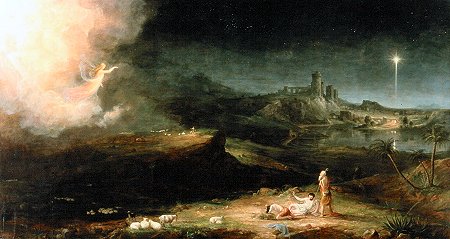I knew the traditional nativity scene had issues.
The three wise men who likely weren’t three and didn’t show up until two years later. The star hovering just above the quaint wooden structure that looks more like an English countryside barn than the back end of an inn. The all-too-pristine setting after an impromptu birth.
I thought I had heard it all.
 I even shared a take on The Christmas Message based on the traditional interpretation just a few days ago. I thought I understood the Christmas story pretty well after nearly four decades of being steeped in Christianity.
I even shared a take on The Christmas Message based on the traditional interpretation just a few days ago. I thought I understood the Christmas story pretty well after nearly four decades of being steeped in Christianity.
Until I heard the theory that Jesus was born away in a manger — but at Migdal Eder and not in a cramped and filthy cave behind a crowded inn.
Migdal What?!
Migdal Eder seems to have been known as the “Tower of the Flock” located not far outside Bethlehem proper. The exact location is unknown though several credible sites have been suggested. Heretical, I know. But bear with me. I think the imagery alone makes it a theory worth considering.
It was Pastor Mark Spansel who offered the theory on the birthplace of Jesus in a recent sermon at our church, although it seems to have been Alfred Edersheim (1899) who gets most of the credit for breathing relatively new life into it. In Chapter 6 of The Life and Times of Jesus Messiah, he allegedly wrote:
And yet Jewish tradition may here prove both illustrative and helpful. That the Messiah was to be born in Bethlehem, was a settled conviction.
Equally so, was the belief , that He was to be revealed from Migdal Eder, ‘the tower of the flock.’ This Migdal Eder was not the watchtower for the ordinary flocks which pastured on the barren sheepground beyond Bethlehem, but lay close to the town, on the road to Jerusalem.
A passage in the Mishnah leads to the conclusion, that the flocks, which pastured there, were destined for Temple-sacrifices, and, accordingly, that the shepherds, who watched over them, were not ordinary shepherds.
The latter were under the ban of Rabbinism, on account of their necessary isolation from religious ordinances, and their manner of life, which rendered strict legal observance unlikely, if not absolutely impossible.
The same Mishnaic passage also leads us to infer, that these flocks lay out all the year round, since they are spoken of as in the fields thirty days before Passover–that is, in the month of February, when in Palestine [Israel] the average rainfall is nearly greatest.
Thus, Jewish tradition in some dim manner apprehended the first revelation of the Messiah from that Migdal Eder, where shepards watched the Temple-flocks all the year round. Of the deep symbolic significance of such a coincidence, it is needless to speak. [emphasis mine]
Here’s the theory in summary. There was place just outside of Bethlehem city, but still within the region commonly known as Bethlehem, where Passover lambs were kept by specially trained and purified shepherds. The lambs were born in this “tower of the flock” known as Migdal Eder under the watchful eye of the shepherds who would then inspect and either certify them for use as sacrifices in the temple or designate them to be released for common use. The new lambs would, according to some sources, even be wrapped in special swaddling clothes once certified.
The Biblical arguments for the theory of Migdal Eder cite the fact that the word translated “manger” in the Gospels could also be translated as “stall” or any holding area for animals — such as Migdal Eder. Cooper P. Abrams III argues this point:
The Greek word which is translated in our English Bibles “manger” is Yatnh phat-ne (pronounced fat’-nay). The definition of the word is of a “stall” where animals are kept and in Luke 13:15 is translated as such. In the Septuagint (Greek translation of the Old Testament) the word means a stall or a crib (See Proverbs 14:4).
Proponents of the theory point to rabbinical writings and Micah 4:8 and other more debatable passages that you can explore as you desire.
And you, O tower of the flock, The stronghold of the daughter of Zion, To you shall it come, Even the former dominion shall come, The kingdom of the daughter of Jerusalem. ~ Micah 4:8
What I Like about It
Here’s what I find fascinating about the theory. First, it places Jesus’ birth in the traditional location for Passover lambs to be born. Fitting, since He became the Passover Lamb of God who took away the sins of the world. Second, it explains how the shepherds knew where to go to find the newborn babe — and why it being wrapped in swaddling clothes would be significant clue. Finally, it explains why those shepherds were notified as it was their holy calling to certify Passover lambs upon birth.
Maybe Jesus was born away in a manger, just not like the one made in China on the shelf at Wal-Mart. But in the “tower of the flock”, Migdal Eder, surrounded by holy shepherds, set apart to certify the birth of the ultimate Passover Lamb.
Jimmy DeYoung has an overly dramatic and under-sourced video at You Tube on the subject that really isn’t all that helpful. And I confess to not being familiar with most of these sources. But the data seems sufficient to entertain the possibile imagery at work here. I welcome comments from others who’ve already explored this one deeper.
What do you make of this interpretation? Of course, we can’t know for sure, but how do these theories affect your view of the birth of Christ? Leave a comment below with your thoughts.
Have you subscribed to our email updates? Click here to sign up to get free FaithWalkers posts in your inbox each week.











